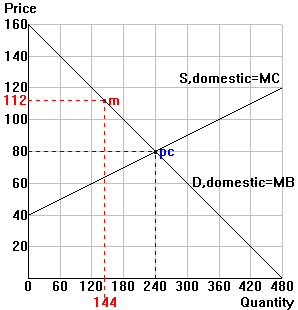
| Jim Whitney | Economics 131 |
Trade under domestic monopoly conditions
Suppose the following depicts domestic demand and cost conditions for
cassette players: 
Part 1: Pretrade (autarky) situation:
Price Output
pc: for a perfectly competitive industry: $ 80
240
m: for a monopoly
industry:
112 144
--Use an "A" to denote the deadweight loss which results from a monopoly.
Part 2: Free trade situation (for a small country):
Hypothetical world price of cassette players (given in class):
______
--In your diagram:
--depict your free trade quantity
produced, consumed and traded.
--use a "B" to denote your gains from
trade if the industry had been perfectly competitive before trade.
Now consider instead the monopoly situation.
--Use "///" to shade the combined pretrade consumer
and producer surplus.
--Use "\\\" to shade the combined free trade consumer and
producer surplus.
--Use a bold outline to inducate the change in national welfare which
results from free trade.
--Comparing your monopolistic pretrade situation and your
free trade situation, decide whether each of the following is true or false:
___ (1) Domestic consumption rises with free trade.
___ (2) Domestic production rises with free trade.
___ (3) The country imports cassette recorders with free trade.
___ (4) The overall gains from trade are larger than they would have
been if the industry had been perfectly competitive before trade.